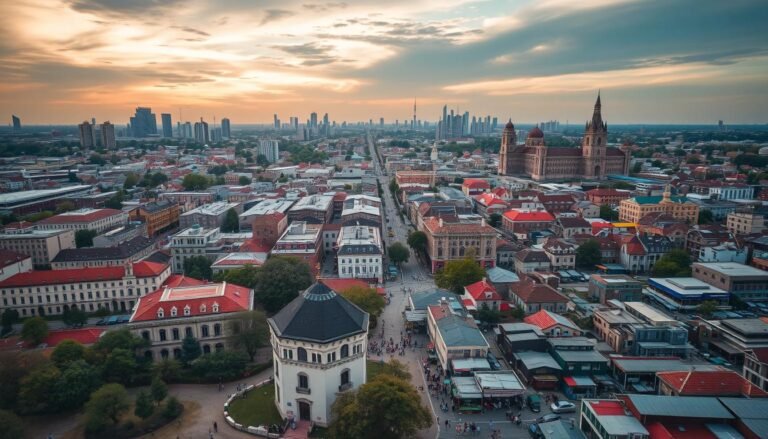Anomie and Its Effects on Society: Durkheim Revisited
Have you ever felt like society’s rules don’t make sense anymore? This feeling of confusion is key to understanding social disorganization. Émile Durkheim’s theory of anomie helps us see how modern societies lack social cohesion.
Anomie means there are no clear social norms. This can cause trust and moral standards to break down. Even in wealthy societies, anomie can happen when income inequality weakens social ties.
In places like post-Soviet Eastern Europe and countries with economic problems, anomie explains social changes. It shows how fast changes can leave people feeling lost and without direction.
Key Takeaways
- Anomie describes a breakdown in social norms and cohesion
- It can occur in both struggling and prosperous societies
- Income inequality can contribute to anomic conditions
- Rapid societal changes often lead to increased anomie
- Durkheim’s theory remains relevant in understanding modern social issues
Understanding Anomie: A Sociological Perspective
Anomie is a key idea in sociology. It comes from Greek and means a society without social norms and values. It helps us see how society breaking down affects people and groups.
Defining Anomie in Sociological Terms
Anomie means a society without rules and traditional social bonds. This can make people feel lost and might lead to more crime.
The Origins of Anomie Theory
The idea of anomie started in the late 1800s with big changes in society. As people moved from farming to cities, they wanted more from life and valued being individuals more. This led to a feeling of being alone.
Durkheim’s Contribution to the Concept
Émile Durkheim’s ideas about anomie are very important. He lived from 1858 to 1917 and talked about it in “The Division of Labour in Society” and “Suicide”. He saw anomie as a lack of rules and morals, which affects how we fit into society.
| Aspect | Pre-Modern Societies | Industrial Societies |
|---|---|---|
| Social Order | Mechanical Solidarity | Organic Solidarity |
| Basis | Shared Collective Conscience | Division of Labor |
| Risk | Low Anomie | High Anomie |
Durkheim showed how important it is to have strong social ties and institutions. His ideas help us understand how society falling apart affects us today.
The Historical Context of Anomie Theory
Anomie theory came about during a time of big changes in society in the late 19th and early 20th centuries. Emile Durkheim, a key figure in sociology, introduced it to look at how modern times affect society. He noticed how moving from traditional to industrial societies changed social bonds and moral values.
The idea of anomie goes way back to ancient Greece and the Bible. Greek thinkers looked at how it affects people and society during hard times. In the Bible, “anomia” meant different kinds of wickedness and social problems.
Durkheim’s work on anomie was important in many historical times. It helped explain society during and after wars, and during economic downturns. For instance, the 2008-2010 recession led to a rise in suicides in the U.S., with 4,750 more people taking their lives than usual.
“Anomie has remained a mainstay in sociological theory and research, reflecting its enduring relevance in understanding societal dynamics.”
Today, anomie is still used to understand modern issues. It’s been applied to places like post-Soviet Eastern Europe and fast-growing economies like China. This shows how the theory can explain social problems in various cultures and economies.
| Time Period | Application of Anomie Theory |
|---|---|
| Late 19th Century | Durkheim’s initial development of the concept |
| Post-World War II | Analysis of social disintegration in war-torn societies |
| 2008 Financial Crisis | Examination of economic upheaval’s impact on social norms |
| 21st Century | Study of rapid societal changes in developing economies |
Durkheim’s Theory of Social Integration and Regulation
Émile Durkheim’s theory looks deeply into how society works. He shows how social structures shape our actions and keep society stable.
Mechanical and Organic Solidarity
Durkheim found two kinds of social bonds. In traditional societies, mechanical solidarity comes from shared beliefs and values. In modern times, organic solidarity comes from needing each other because of different jobs. This change affects how connected we feel.
Social Norms and Order
Social norms keep things in order. They tell us how to act, making us feel part of a group and giving us a common goal. Without these norms, we might feel lost and without purpose.
Consequences of Social Breakdown
When society falls apart, things can get really bad. Durkheim studied suicide and found four main reasons. Each reason is linked to how well society holds together.
| Suicide Type | Cause | Social Integration |
|---|---|---|
| Anomic | Lack of social regulation | Low |
| Egoistic | Lack of social integration | Low |
| Altruistic | Excessive social integration | High |
| Fatalistic | Excessive social regulation | High |
There’s been a rise in suicides at work, showing society might be breaking down at our jobs. This shows Durkheim’s ideas are still important today. We need strong social bonds to stop feeling lost and to keep society together.
Anomie and Its Effects on Society: Durkheim Revisited
Emile Durkheim’s idea of anomie helps us grasp today’s social problems. He found that more people take their own lives during economic ups and downs. This shows how big changes in society affect people’s happiness.
When society gets disorganized, it can break down. This leads to a loss of trust and weak moral values. The Perception of Anomie Scale (PAS) measures these issues. It shows how a country’s social state affects its people’s feelings and well-being.
Feeling left out is a big part of anomie. Fast-changing societies can make people feel out of place with their surroundings. This can make people more alone and doubt their leaders. Places like Bulgaria, Iran, and China face these issues due to social or economic problems.
“Anomie is a perceived breakdown in social fabric and leadership legitimacy.”
In anomic societies, more people act out. When what society wants is more than what people can achieve, unhappiness grows. This gap between goals and means can cause more crime and suicide. Durkheim thought that bringing people together could lessen these problems.
Today, we see anomie in many areas, from young people’s suicides to economic worries and political issues. As societies change, understanding and tackling anomie is key. It helps keep society stable and people happy.
Types of Suicide in Durkheim’s Framework
Émile Durkheim’s theory on suicide is key in sociology. He looked into how being part of a group and societal rules affect suicide rates. Durkheim found four main types of suicide, each showing different levels of social connection and control.
Egoistic Suicide
Egoistic suicide happens when people feel left out of society. Not having friends or family can make someone more likely to take their own life. This type often hits those who can’t fit in with others.
Altruistic Suicide
Altruistic suicide is the opposite, happening when people are too connected to their groups. It’s not common but can happen in close communities where people give up for the group’s sake.
Anomic Suicide
Anomic suicide is linked to a breakdown in society’s rules. Studies show more suicides when the economy is down. This type shows a lack of social norms and goals.
Fatalistic Suicide
Fatalistic suicide comes from feeling trapped in a strict society. It’s not common but can happen in places where people feel they have no way out.
| Suicide Type | Social Integration | Societal Regulation |
|---|---|---|
| Egoistic | Low | Moderate |
| Altruistic | High | Moderate |
| Anomic | Moderate | Low |
| Fatalistic | Moderate | High |
Recent studies have built on Durkheim’s ideas, adding social network and cultural sociology views. These new insights show how social factors affect mental health, helping us find ways to prevent suicide.
The Division of Labor and Anomie
Emile Durkheim’s work, “The Division of Labor in Society,” was published in 1893. It looked at how labor specialization affects social unity. Durkheim believed that as societies grow more complex, the division of labor increases. This can lead to social disorganization and a lack of norms.
In today’s world, more specialization should make us rely on each other. But often, it leads to feeling alone and fighting. Economic growth and market expansion can break social bonds, causing crises and conflicts. This is called anomic division of labor, where competition takes over and personal goals beat group goals.
Studies show that fast changes in society, like moving from a dictatorship to a democracy, can make people feel lost. A study of 38,845 people from 30 countries found that feeling lost is linked to one’s social and economic spot in society. This shows how fast changes in modern times can make people feel powerless and disconnected.
“Anomie refers to ‘normlessness,’ powerlessness, alienation, and confusion regarding rules in sociology.”
Since Durkheim’s time, the idea of anomie has grown. It was forgotten in the 1940s but came back from the late 1980s to now. Today, anomie theory helps us grasp how fast changes in society can cause social disorganization. It gives us clues on how to build stronger social structures in our complex world.
Modern Interpretations of Anomie Theory
Sociologists today are updating Durkheim’s ideas for our modern world. They look at how fast technology changes and global connections lead to new kinds of social problems.
Extending Durkheim’s Concepts
Now, we use Durkheim’s theories to understand today’s social issues. For instance, studies show that more people in the U.S. and around the world are taking their own lives. This is because social connections are getting weaker.
This matches what Durkheim said a long time ago. He believed that when society breaks down, people might turn to extreme actions like suicide.
Critiques and Limitations
Some people say Durkheim’s ideas have some problems. They argue that he was too focused on groups and not enough on individuals. But, his theory is still important for understanding how societies can fall apart.
Recent studies have found that being part of a strong community can help prevent suicide. This supports Durkheim’s idea that being connected to others is key to our well-being.
| Durkheim’s Concept | Modern Application |
|---|---|
| Social Integration | Protective against suicide |
| Regulation | Norm changes increase suicide risk |
| Sacred Bonds | Needed to unite society |
Even with its flaws, Durkheim’s work is still very relevant today. His ideas about finding a balance between personal freedom and community life are still useful in our modern societies. By looking back at his theories, we can better understand issues like feeling alone and extreme actions.
Measuring Anomie: Challenges and Approaches
Measuring anomie is tough in sociological research. It’s hard to capture the complex nature of social disorganization. Researchers use new methods to try to measure this tricky concept.
The Perception of Anomie Scale (PAS)
The Perception of Anomie Scale (PAS) is a key tool for sociologists. It looks at how people see society falling apart and leadership failing. This helps researchers understand how much social disorganization is in a community.
Distinguishing Societal-Level Anomie from Individual Outcomes
It’s hard to tell apart societal anomie from personal experiences. Researchers use different ways to measure it:
- Surveys with the PAS
- Looking at society’s signs (crime rates, economic gaps)
- Checking social trust levels
By using these methods together, sociologists get a fuller picture of anomie in society.
| Year | Researcher(s) | Contribution |
|---|---|---|
| 1975 | Teevan | Modified Srole Scale for measuring anomia |
| 2011 | Heydari et al. | Multidimensional scale for assessing feeling of anomie |
| 2019 | Bashir and Bala | Scale to measure anomie in students |
| 2021 | Yarim et al. | Organizational Anomie Scale reliability study |
| 2022 | Vilca et al. | Social Anomie Brief Scale (SAS-10) validation |
These new ways of measuring anomie show how researchers are working hard. They aim to improve their methods and understand social disorganization better in today’s societies.
Anomie in the Digital Age: New Perspectives
The digital age brings new challenges to how we see anomie. Technology changes social norms, and social media changes how we connect. This change makes us rethink Durkheim’s theory.
A 2018 study looked at 100 countries and found interesting things. It showed that more development can actually make anomie worse. Cities getting bigger and more people moving in also made anomie go up, just like Durkheim said. But, surprisingly, social inequality didn’t really affect anomie, which goes against Merton’s ideas.
The digital world is a mix of good and bad. It gives us new ways to meet people, but it can also make us feel alone. Online groups might break down old social rules, making us feel lost. The fast pace of new technology can also pull us away from our social groups.
“The Internet has become the great equalizer, but also the great divider.”
Now, researchers are looking into how digital tech affects how we stick together and trust each other. They’re studying how online groups form and what values they share. It’s important to understand these things to tackle anomie in our digital world.
| Factor | Impact on Anomie |
|---|---|
| Development | Strong negative effect |
| Urbanization | Positive effect |
| Population Growth | Positive effect |
| Social Inequality | No significant effect |
Societal Implications and Potential Solutions
Emile Durkheim introduced the idea of anomie over a century ago. It helps us understand how social disintegration affects us. Studies in 28 countries show a link between anomie and how well societies function and how happy people are.
Addressing social disintegration and deregulation
To fight anomie, we need to strengthen our social ties and leadership. This means building trust, following moral rules, and having good governance. The PAS shows that weak social ties and poor leadership go hand in hand. We need to fix both to reform institutions fully.
The role of institutions in mitigating anomie
Institutions are key to social unity. Schools can teach people to bounce back and cope with stress. Mental health programs, like India’s tele-manas, help people deal with anomie’s effects. Durkheim even suggested stricter divorce laws to lessen instability in good economic times.
Building social cohesion and resilience
Building communities is vital to fight anomie. We should encourage people to connect, engage in culture, and feel they belong. This helps people handle life’s challenges better. By tackling anomie at both the group and individual levels, we can build stronger, united communities.
Source Links
- Revisiting the Measurement of Anomie
- Anomic suicides on rise during recently emerging crises: revisiting Durkheim’s model | CNS Spectrums | Cambridge Core
- someTitle
- Toward a General Theory of Anomie The Social Psychology of Disintegration | European Journal of Sociology / Archives Européennes de Sociologie | Cambridge Core
- Anomie Manuscript
- Anomie: History of the Concept
- Institutional suicide as anomie: decedents speak out for work-related suicides through a Durkheimian exploration of suicide notes in a context without institutional responsibilization for suicide prevention
- When Too Much Integration and Regulation Hurts
- Durkheim’s Theory of Anomie Revisited
- Discourse on the Durkheimian Tradition in Political Sociology
- The Limits of Social Capital: Durkheim, Suicide, and Social Cohesion
- The Social Roots of Suicide: Theorizing How the External Social World Matters to Suicide and Suicide Prevention
- Revisiting sociology’s first classic:The division of labor in society and its actuality – Sociological Forum
- Frontiers | The Social Roots of Suicide: Theorizing How the External Social World Matters to Suicide and Suicide Prevention
- Did Emile Durkheim Foresee Today’s Chaos? – Social Science Space
- Adaptation and Validation of the Perception of Anomie Scale in Chilean University Students
- Anomie in the sociological perspective of Émile Durkheim
- Gender Anomie in the Digital Era







